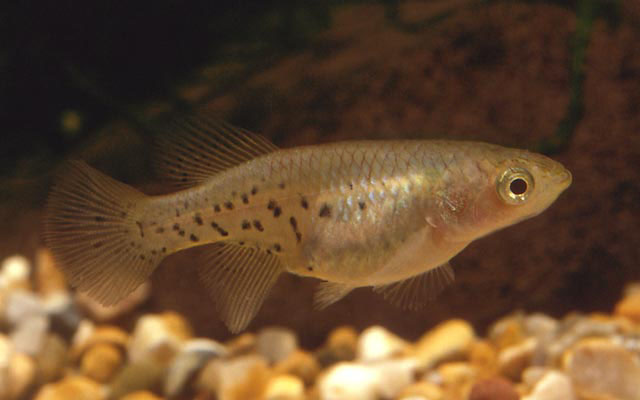|
Dorsal spines (total): 0-0; Dorsal soft rays (total): 15-17; Anal spines: 0-0; Anal soft rays: 16-19; Vertebrae: 30-32. Diagnosis: Distinguished from all congeners by the combination of the following character states: caudal fin red with black posterior margin in males, narrow white margin to dorsal and anal fins, and silver iris; posterior portion of flank and unpaired fins with black spots in females; pre-dorsal length in males 62.4-65.1% of standard length; 5 + 15-16 gill-rakers on first branchial arch; 29-31 scales in longitudinal series; 16-18 series of scales around caudal peduncle; two longitudinal rows of scales between anterior supraorbital series of neuromasts; anterior supraorbital series of neuromasts arranged continuously, with four well-developed neuromasts; four neuromasts in posterior supraorbital series; 29-31 caudal-fin rays; 30-31 vertebrae; second proximal radial of dorsal fin between neural spines of 13th and 15th vertebrae (Ref. 83514, 122075). This species differs from Nothobranchius lucius in having a plain red caudal fin with narrow margin at the upper and lower corners in male (Ref. 83514).
Description: Dorsal and ventral profiles slightly convex from snout to posterior end of dorsal and anal-fin bases, approximately straight on caudal peduncle; body moderately deep, compressed; greatest body depth at vertical just in front of pelvic-fin base (Ref. 122075). Jaws short, snout slightly pointed in lateral view; mouth superior, lower jaw slightly anterior to upper jaw; jaw teeth canine, numerous, irregularly arranged; outer teeth greater than internal teeth; vomerine teeth 8-12 (Ref. 122075). Branchiostegal rays 6; gill-rakers of first branchial arch 5 + 15-16; basihyal sub-triangular, greatest width about 85% of length; basihyal cartilage about 80% of total length of basihyal (Ref. 122075). Dorsal and anal fins broad in males, extremity rounded, with short filamentous rays along distal margin; in females, dorsal fin rounded, anal fin sub-triangular and slightly longer than dorsal fin; caudal fin subtruncate to rounded; pectoral fin sub-elliptical, posterior extremity between pelvic-fin base and anus; pelvic fin small, tip reaching between urogenital papilla and anal-fin origin; pelvic-fin bases medially in contact; in males, minute papillate contact organs on first and second pectoral-fin rays and distal portion of middle dorsal-fin rays, and rows of well-developed papillate contact organs along two-thirds of most rays of anal fin; dorsal-fin origin on vertical between base of second and fourth anal-fin rays; dorsal-fin rays 15-17; anal-fin rays 16-19; caudal-fin rays 29-31; pectoral-fin rays 18-21; pelvic-fin rays 6 (Ref. 122075). Scales small, cycloid; body and head entirely scaled, except ventral surface of head; minute filamentous contact organs along posterior margin of scales on middle portion of flank and latero-ventral portion of head in males; body squamation extending over anterior 30% of caudal-fin base; no scales on dorsal and anal-fin bases; frontal squamation irregularly arranged in two longitudinal rows between anterior supraorbital neuromast series; longitudinal series of scales 29-31; transverse series of scales 9-11; scale rows around caudal peduncle 16-18 (Ref. 122075). Anterior supraorbital series of neuromasts arranged in single section placed in nearly continuous depression, with five neuromasts; posterior supraorbital series with four neuromasts placed in shallow depression; infraorbital series with 18-25 neuromasts, pre-opercular series 15-18, mandibular 17-21; one neuromast per scale of lateral line; two neuromasts on caudal-fin base (Ref. 122075). Total vertebrae 30-32; second proximal radial of dorsal fin between neural spines of 13th and 15th vertebrae; first proximal radial of anal fin between pleural ribs of 12th and 15th vertebrae; ventral process of post-temporal well-developed; hypurals completely fused, forming single hypural plate without vestige of median gap (Ref. 122075).
Colouration: Colouration in life for males: flank light green to light greenish blue; posterior margin of scales red, forming red reticulate pattern, often with narrow chevron-shaped red bars overlapping red reticulum on posterior half of flank; dorsum pale brown, venter yellowish white; side of head light greenish blue; jaws, dorsal and ventral parts of head pale yellow; red pigmentation forming reticulate pattern on post-orbital region, often forming three oblique, short red bars; iris light blue; dorsal fin pale yellow, with dark red transverse oblique bars with irregular sinuous margins, broader on basal and posterior portions of fin; distal filaments white; anal fin pale yellow, basal portion with red bars irregularly arranged; filaments light grey with white tips; caudal fin red, with dorsal and ventral posterior corners of fin black, sometimes black pigmentation extending along whole posterior border, forming narrow black posterior margin; pectoral fin yellowish hyaline, with bluish white distal margin, wider dorsally; pelvic fin pale yellow with small red spots; margins white; often black pigmentation concentrated on subdistal portion of fin; in some males collected in the middle Ruvu River basin and Lower Rufiji River basin, red pigmentation was absent, making exemplars predominantly pale blue (Ref. 122075). Colouration in life for females: flank pale brown, often with horizontal rows of pale greenish blue spots on anterior portion; black dots on posterior portion of flank, and few dark grey on anterior portion; dorsum pale brown, venter white; head pale brown, opercular region pale greenish yellow; iris pale yellow; fins hyaline, with grey dots on basal portion of unpaired fins (Ref. 122075). |
| Found in temporary pools in floodplains, rice fields, swamps, ditches and small streams (Ref. 3788). Found in water-filled depressions in floodplains of rivers; with vegetation often near edges, usually grasses; occasionally grasses cover the entire pool; if aquatic vegetation is present, it may comprise of Nymphea, Ottelia, Lagarosiphon, and Utricularia species; annual species; eggs deposited in substrate where they survive dry season; hatching at onset of wet season; rapid growth of fry; sexual maturity may be attained in six weeks; may be associated with other annual or non-annual fish species (Ref. 83514). Bottom spawner; 4 months incubation; difficult to maintain in aquarium (Ref. 27139). |
